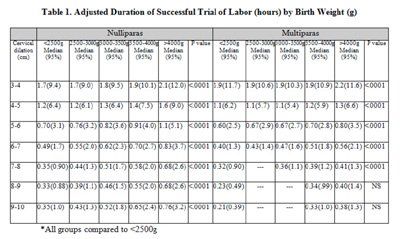ACOG: Increased Birth Weight Slows Labor, May Alter Labor Curve
A study presented at the American Congress of Obstetricians and Gynecologists’ Annual Clinical Meeting indicates that as birth weight increases, progression in labor is slower in both successful trial of labor and patients who ultimately have cesarean deliveries.
A study presented at the American Congress of Obstetricians and Gynecologists’ Annual Clinical Meeting indicates that as birth weight increases, progression in labor is slower in both successful trial of labor and patients who ultimately have cesarean deliveries.
“With the c-section rate escalating, now at 32.8%, current research has been focusing on variables which might alter or [indicate] a slower labor curve and challenging that one labor curve can actually apply to all women,” said lead author Heidi Leftwich, DO, from the University of Illinois in Chicago.
In 2010, the Consortium of Safe Labor (Zahng, et. al.) released data on the labor patterns in a large modern obstetric population that indicated longer times to progression from 4 to 6 centimeters dilation. “[This suggested] that it may be beneficial to continue [laboring] for a longer period of time up until approximately 6 centimeters of cervical dilation. This may, ultimately decrease the amount of intrapartum C-sections and therefore repeat cesarean sections,” Leftwich said.
Using labor and delivery records from the Consortium of Safe Labor the study included 146,904 maternal records from 12 clinical centers (19 hospitals) from 2002-2008. Patients with malpresentation, fetal anomalies, elective repeat cesarean, multiple gestations, gestational age less than 34 weeks and less than two cervical exams were excluded. Distribution of times for cervical dilation progression (“traverse times”) were determined by interval censored regression analysis.
Birth weight categories include less than 2,500 g, 2,500-3,000g, 3,000-3,500g, 3,500-4,000g and greater than 4,000g. Cesarean sections occurred in 20.6%, 13.5%, 13.5%, 17.0% and 25.1%, respectively within the increasing birth weight categories. Both in successful trial of labor and patents who ultimately delivered via cesarean, nulliparous traverse times increased as birth weight increased (p < 0.0001). (See Table 1 - click to full size)

In multiparous women with successful trial of labor, traverse times increased as birth weight increased from 5-8 centimeters (p< 0.0001). From 8-10 cm, traverse times increased by birth weight, though not statistically significant secondary to limited cervical exams.
While it is commonly accepted that higher birth weights lead to longer dilation progression and labors, there has been little research to support this maxim. Leftwich said that the pregnant population has changed significantly since the normal labor curve was created, and it may not currently apply to all women, making research on potential factors that influence labor important in today’s research efforts.
S1E4: Dr. Kristina Adams-Waldorf: Pandemics, pathogens and perseverance
July 16th 2020This episode of Pap Talk by Contemporary OB/GYN features an interview with Dr. Kristina Adams-Waldorf, Professor in the Department of Obstetrics and Gynecology and Adjunct Professor in Global Health at the University of Washington (UW) School of Medicine in Seattle.
Listen
Study shows a healthy prenatal diet could be upstream obesity prevention strategy
December 26th 2024"Our findings support the recommendation of a healthy diet based on the current guidelines (as measured by the HEI) during pregnancy, since it may reduce patterns of infant growth outside reference ranges."
Read More
Early pregnancy cannabis use high in states with recreational legalization
November 11th 2024A population-based time-series analysis California before, during and after legalization show a rising trend in women using cannabis while pregnancy especially when the state has legalized the drug.
Read More
